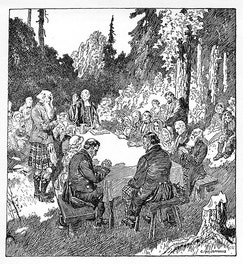Historical Landmarks in and Around Hamilton, Ontario
Library and Archives Canada, Acc. No. 1972-26-365
Remarks
C.W. Jefferys' notes about this picture from The Picture Gallery of Canadian History Volume 2
The gates of Dundurn once formed the entrance to the estate of George Rolph at Dundas, Ont. In 1855 Allan MacNab purchased them from him and brought them to Dundurn. The iron gates were made in England, but the pillars and wall were cut from Dundas Mountain stone. On the inside of the entrance is a tablet bearing the inscription: "John Allen, Stone Cutter, Staffordshire, England. Emigrated to Canada in 1820. In 1828 he constructed these pillars and erected this monument, that he lived and will die a faithful subject to his King and Country, and proud of his national birth."
The stone marked G.R. is one of several along the York Road (originally Dundas Street). The initials have been wrongly supposed to represent Georgius Rex; but really are those of George Rolph, who thus marked the boundary of his property. The stones are set upright well into the ground, the letters being about four inches high. A similar stone is to be seen in the neighbourhood marked R.H. No. 3, indicating the boundary of the property of Richard Hatt.
Crooks' Hollow is situated near Greenville, on the creek which flows over Webster's Falls of today. It takes its name from James Crooks, a leading merchant of Upper Canada, who made a settlement here about 1800. Mills were erected, and industries flourished until the water power failed. Here was established a mill, to which was awarded a bonus for turning out the first sheet of paper manufactured in Upper Canada. All that remains of it today is the stone foundation of a barn. Helliwell, the man who ran it, also established a paper mill on the Don, north of Toronto.
Published References
- Jefferys, Charles W. 1945 The Picture Gallery of Canadian History Volume 2, p.242




Comments